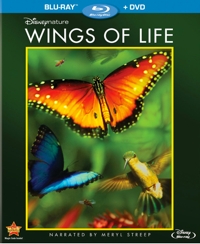 Grade: C+
Grade: C+
Entire family: No
2011, 80 min., Color
Rated G
Disney
Aspect ratio: 1.85:1
Featured audio: DTS-HD MA 5.1
Bonus features: D
Includes: Blu-ray, DVD
Trailer
In our house, any film that doesn’t hold the kids’ interest after 20 minutes can be turned off, because life is too short to spend it watching unsatisfying movies or TV shows.
Disneynature: Wings of Life is far from a bad film, but it struck me as one with a core premise that also posed an impossible challenge. How do you focus primarily on time-lapse photography and dramatically slowed-down video, yet avoid slowing down the narrative in the process? And how do you make a subject like flowers and pollination seem interesting?
To my mind, you don’t do it with the kind of hushed-voice narration we heard in the early days of nature filmmaking. My kids were already rolling their eyes as the sedate narrator talked in the kind of soothing voice that hypnotists use. It’s a wonder narrator Meryl Streep didn’t put herself to sleep, the lines are so pedestrian and the delivery so very, very somnolent.
And when that voice announced five minutes into the film, “I am a flower,” I thought my kids were going to toss their bowls of popcorn. That’s the somewhat hokey narrative angle writer-director Louie Schwartzberg chose for Wings of Life, which, I told the kids, ought to be called “Pollen” because it’s what the film is really about. As it turns out, Pollen is the title it’s known by in France. When it was originally shown in the U.K., though, this 80-minute documentary was called Hidden Beauty: A Love Story That Feeds the Earth. Now in the U.S., it’s Wings of Life. I’m no marketing whiz, but isn’t it a sign of trouble when a film has to be renamed over and over again to try to attract an audience?
 The sad part is that Wings of Life, a French-American production, features never-before-seen time-lapse photography of bees, butterflies, birds and bats interacting with flowers. Slowed down with new technology that permits us to see what hasn’t been seen before in the world of rapid movement, it’s actually quite beautiful and phenomenal. But the cinematography is enhanced by special effects, and that complicates matters for nature-show purists who will wonder when the images are unadulterated cinematography and when they’re CGI-enhanced.
The sad part is that Wings of Life, a French-American production, features never-before-seen time-lapse photography of bees, butterflies, birds and bats interacting with flowers. Slowed down with new technology that permits us to see what hasn’t been seen before in the world of rapid movement, it’s actually quite beautiful and phenomenal. But the cinematography is enhanced by special effects, and that complicates matters for nature-show purists who will wonder when the images are unadulterated cinematography and when they’re CGI-enhanced.
Tone and pacing aside, there are lessons to be learned here, and Disney’s illumination of the species that help with pollination provide some moments nature fans will have never seen before. A hummingbird twirling in midair pursuit of a bug is particularly stunning, as are pregnant bats feasting on flowers that open for just a single night. Still, I have to believe there has to be a way to tell the story of pollination and showcase the gorgeous photography without turning the film into a virtual screensaver. My kids never made it to the bats because, unlike “Disneynature: Chimpanzee,” this film lacks an emotional core.


Leave a comment